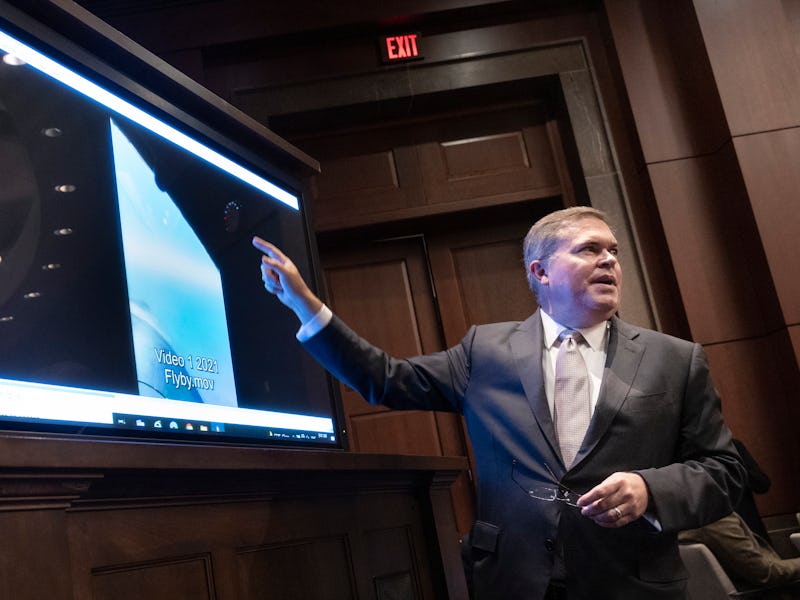The first congressional hearing on UFOs in 50 years shows America’s interest in aliens will never fade
In the 1960s, just as now, the US military expressed great interest in UFOs.

On Tuesday, May 17, members of the US Congress gathered with military personnel to publicly discuss a rather unusual topic: UFOs. Or, as the US military now calls them to avoid the stigma of that name, unidentified aerial phenomena, or UAPs.
Although it is the first Congressional hearing on the topic in over half a century, it isn't entirely new airspace for Congress (so to speak). And for all the curiosity of elected officials grilling military intelligence about something academics generally don't take very seriously, the topic highlights a mundane question: Is it possible to look up at the sky and identify, with certainty, every vehicle—every perfectly mundane human-made drone or aircraft—that flies up there?
The answer is almost certainly no.
“There’s no illusion that we’re going to be able to, 100 percent, have perfect surveillance,” says Andrew Weinert, a member of the Homeland Protection and Air Traffic Control Division at MIT Lincoln Laboratory. “It would be great if we did.”
It is true that Tuesday’s event was the first public congressional hearing into UFOs since 1966, when a cluster of sightings emerged from southern Michigan. Investigators concluded that the sightings were due to pranks, swamp gas, or misidentified celestial objects. But future president Gerald Ford, who then sat in Congress representing a constituency in the area, wasn’t satisfied with that explanation. (Incidentally, Ford’s future presidential successor, Jimmy Carter, himself reported a UFO sighting not long after.)
In the 1960s, just as now, the US military expressed great interest in UFOs. In 1947, not long after a civilian pilot named Kenneth Arnold described strange objects he'd seen in midair as “flying saucers,” the Air Force launched its first investigation. That led to Project Blue Book, which studied over 12,000 UFO sightings.
Just as nothing extraordinary came from Ford’s efforts, those projects' conclusions stayed grounded. Most sightings, they found, had an explanation under analysis. At least publicly, the project said there was “no evidence” that UFOs represented aliens or advanced technology. When Project Blue Book shut down in 1969, only 701 sightings remained unidentified.
But that wasn't the end of the military’s obsession with UFOs. Military pilots kept reporting seeing unidentified objects, including a now-public 2004 incident when US Navy personnel saw what they purported to be a capsule-shaped object that mirrored jets' movements.
Around that time, several more senators—most notably Harry Reid of Nevada, supported by the billionaire founder of NASA contractor Bigelow Aerospace—began pushing for a new US Department of Defense effort to investigate these phenomena. Quietly, in 2007, their efforts led to the creation of the Advanced Aerospace Threat Identification Program (AATIP).
AATIP lasted until 2012, followed by a succession of other programs, the latest of which is called the Airborne Object Identification and Management Synchronization Group. They weren't technically classified, but their existence flew under the radar until 2017, when AATIP's director Luis Elizondo, feeling that UFOs represented advanced technology and that his and his colleagues' efforts weren’t being taken seriously, leaked details to the press — including video from pilots.
The leak sparked a new wave of public interest in a subject that had never really faded from Americans' minds over the long decades. In June 2021, the Pentagon acquiesced to mounting public pressure and released a report on AATIP's preliminary findings. More recently, in April of this year, some 1500 pages of AATIP's work were declassified.
Certainly, some view the sightings as representing some sort of advanced science. AATIP tapped researchers to probe such grounded topics as "vacuum engineering," "gravitational wave communications," and "the manipulation of extra dimensions."
US lawmakers are paranoid that, whatever they are, they're a risk to their country's security. "The many threats they pose need to be investigated," said Democrat André Carson at the hearing this week. "The intelligence community has a serious duty…to prevent potential adversaries such as China and Russia from surprising us with unforeseen new technologies," said Republican Rick Crawford at the recent hearing.
Far from aliens or superweapons, it's entirely likely that the sightings might have relatively uninspiring, if elusive, explanations. Outside observers have pointed out that the Navy pilots' 2004 sighting, for instance, could have been a software glitch.
For some people in the aerospace community, however, the hearings circle about a rather more earthly topic: Can we look up at the sky and know what and where every flying object is?
In truth, we can’t. Doing that would be far too expensive and utterly impractical.
“You’re able to go with your small general aviation aircraft today, and take off,” says Weinert. “You don’t need to be equipped with a transponder. You don’t have to broadcast your information. In some places, you can just go fly.”
Weinert believes that the affair highlights a double standard between ground traffic and its aerial counterparts. Even though few people expect automobiles on roads to follow any sort of constant monitoring, he says, many hold that very expectation of aircraft.
Analyzing UFOs, importantly, shouldn’t automatically mean assuming aliens or dimensional travelers. And with renewed interest in the subject, these congressional hearings could lead to some more lasting change in how officials discuss the subject of unidentified craft, whatever they are.
The challenge, says Weinert, “is resolving the difference between what the public expects and what the reality of the situation is.”
This article was originally published on